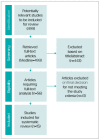Effects of physical exercise at the workplace for treatment of low back pain: a systematic review with meta-analysis
- PMID: 32270086
- PMCID: PMC7104834
- DOI: 10.5327/Z1679443520180133
Effects of physical exercise at the workplace for treatment of low back pain: a systematic review with meta-analysis
Abstract
Background: The prevalence of low back pain is high among the economically active population. Low back pain reduces productivity and causes absenteeism, impaired quality of life and leaves of absence. Several measures were suggested to reduce the occurrence of this occupational condition, among which physical exercise at the workplace stands out.
Aim: To analyze studies which assessed physical exercise at the workplace for treatment of low back pain.
Methods: The present study consisted of a systematic review with meta-analysis. An electronic search was conducted on database MEDLINE using keywords "workplace," "low back pain" and "exercise," synonyms and headings located on Health Sciences Descriptors and Medical Subject Headings. We considered all the studies that included physical exercise at the workplace and defined low back pain as outcome.
Results: We located 499 potential studies and finally included 15 for review. The duration of treatment varied from 3 weeks to 18 months, and the main interventions were strength and stretching exercises and muscle relaxation.
Conclusions: The meta-analysis showed that physical exercise at the workplace did not reduce the occurrence of low back pain (difference of means=0.62, 95%CI -0.8-2.04, p<0.4). The present systematic review was registered in database PROSPERO, registration number CRD42017071563.
Contexto: A dor lombar apresenta alta prevalência na população economicamente ativa, promovendo a diminuição da capacidade produtiva, absenteísmo, prejuízos à qualidade de vida e afastamento previdenciário. Medidas diversas têm sido adotadas no intuito de diminuir esse infortúnio laboral, destacando-se a prática de exercício físico no ambiente de trabalho.
Objetivo: O objetivo desta revisão foi identificar estudos que utilizaram o exercício físico realizado no ambiente laboral para tratamento da dor lombar.
Métodos: Trata-se de uma revisão sistemática com metanálise. Foi realizada busca eletrônica na base de dados MEDLINE utilizando os descritores “workplace”; “low back pain” e “exercise” e os respectivos sinônimos e palavras-chaves identificados nos Descritores em Ciências da Saúde e no Medical Subject Headings.
Resultados: Foram considerados todos os estudos que adotaram exercício físico no ambiente de trabalho e possuíam desfechos relacionados à dor lombar. Foram encontrados 499 estudos em potencial, resultando na inclusão final de 15 artigos. O tempo de tratamento variou de 3 semanas a 18 meses, e as principais intervenções foram exercícios de força, alongamentos e relaxamento muscular.
Conclusão: A metanálise demonstrou que não há efeito do exercício físico no ambiente de trabalho na redução da percepção da dor lombar (diferença entre médias=0.62, CI95%, -0.8,2.04; p<0.4). Esta revisão sistemática foi registrada no PROSPERO, sob protocolo CRD42017071563.
Keywords: exercise; low back pain; workplace.
Figures
Similar articles
-
Yoga compared to non-exercise or physical therapy exercise on pain, disability, and quality of life for patients with chronic low back pain: A systematic review and meta-analysis of randomized controlled trials.PLoS One. 2020 Sep 1;15(9):e0238544. doi: 10.1371/journal.pone.0238544. eCollection 2020. PLoS One. 2020. PMID: 32870936 Free PMC article.
-
Workplace interventions for increasing standing or walking for decreasing musculoskeletal symptoms in sedentary workers.Cochrane Database Syst Rev. 2019 Nov 17;2019(11):CD012487. doi: 10.1002/14651858.CD012487.pub2. Cochrane Database Syst Rev. 2019. PMID: 31742666 Free PMC article.
-
Prevention of relapsing backache.GMS Health Technol Assess. 2006 May 24;2:Doc12. GMS Health Technol Assess. 2006. PMID: 21289963 Free PMC article.
-
Effects of a workplace exercise program on physical capacity and lower back symptoms in hospital nursing assistants: a randomized controlled trial.Int Arch Occup Environ Health. 2021 Feb;94(2):275-284. doi: 10.1007/s00420-020-01572-z. Epub 2020 Sep 16. Int Arch Occup Environ Health. 2021. PMID: 32936370 Clinical Trial.
-
Occupational interventions for the prevention of back pain: Overview of systematic reviews.J Safety Res. 2018 Sep;66:39-59. doi: 10.1016/j.jsr.2018.05.007. Epub 2018 May 20. J Safety Res. 2018. PMID: 30121110
Cited by
-
Effectiveness of warm-up interventions on work-related musculoskeletal disorders, physical and psychosocial functions among workers: a systematic review.BMJ Open. 2023 May 2;13(5):e056560. doi: 10.1136/bmjopen-2021-056560. BMJ Open. 2023. PMID: 37130661 Free PMC article.
-
The Effects of Workplace Interventions on Low Back Pain in Workers: A Systematic Review and Meta-Analysis.Int J Environ Res Public Health. 2021 Nov 30;18(23):12614. doi: 10.3390/ijerph182312614. Int J Environ Res Public Health. 2021. PMID: 34886343 Free PMC article.
-
[Physical activity on pain in musculoskeletal disorders in the workplace. A systematic review of Randomized Controlled Trials].Aten Primaria. 2025 Jun 27;57(11):103324. doi: 10.1016/j.aprim.2025.103324. Online ahead of print. Aten Primaria. 2025. PMID: 40580565 Free PMC article. Spanish.
-
Organizational Justice and Health: A Survey in Hospital Workers.Int J Environ Res Public Health. 2022 Aug 8;19(15):9739. doi: 10.3390/ijerph19159739. Int J Environ Res Public Health. 2022. PMID: 35955099 Free PMC article.
-
Diaphragmatic breathing exercises in recovery from fatigue-induced changes in spinal mobility and postural stability: a study protocol.Front Physiol. 2023 Jun 29;14:1220464. doi: 10.3389/fphys.2023.1220464. eCollection 2023. Front Physiol. 2023. PMID: 37457029 Free PMC article.
References
Publication types
LinkOut - more resources
Full Text Sources


